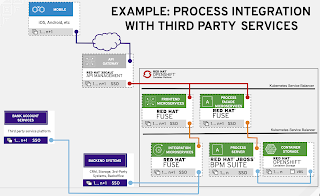In Part 6 of this series, we looked into details that determine how your integration becomes the key to transforming your customer experience. It started with laying out the process of how I’ve approached the use case by researching successful customer portfolio solutions as the basis for a generic architectural blueprint.
Having completed our discussions on the blueprint details, it’s time to look at a few specific examples. This article walks you through an example integration scenario showing how expanding the previously discussed details provides blueprints for your own integration scenarios.
Blueprint scenario
As mentioned before, the architectural details covered here are based on real customer integration solutions using open source technologies. The example scenario presented here is a generic common blueprint that was uncovered researching customer solutions. It’s my intent to provide a blueprint that provides guidance and not deep technical details.
This section covers the visual representations as presented, but it’s expected that they’ll be evolving over time. There are many ways to represent each element in this architectural blueprint, but I’ve chosen icons, text, and colors that I hope are going to make it all easy to absorb. Feel free to post comments at the bottom of this post, or contact me directly with your feedback.
Figure 1: Process integration.
Now let’s take a look at the details in this blueprint and outline the solution.
Process integration
The example blueprint shown in Figure 1 outlines how to integrate automation into your architecture. In this example, starting from the top, a mobile device is used to connect to your services through an API gateway. It’s leveraging a group of microservices that provide front-end functionality, everything from push notifications, synchronization, to simple more complex activities that front-end applications need to service their clients.
These front-end microservices are gathering data and information from the various organizational backend systems by working through integration microservices. There is a conscious effort here to keep this blueprint example as concise as possible, therefore the integration of various potential back-end systems has been simplified to a single representative box.
When interaction with process automation is desired, the mobile application works with process facade microservices that expose any functionality of the process server, which leverages container native storage highlighting container-based storage options featured by container platforms.
Third-party services
Figure 2: Process integration with third-party services.
As many organizations have to deal with third-party legacy decisions in their architectures, it makes sense to show the versatility that open source integration technology offers. It’s easy to lean on metaphors where open standards in open source integration solutions offer organizations the versatility of a Swiss Army knife.
The blueprint shown in Figure 2 expands the original process integration use case with a third-party service platform.
Without specifying this third-party service platform, it’s clear that leveraging the integration microservices an organization can establish a separation from legacy technology choices that might not be standing the test of time.
What’s next
This overview covers the first example architecture blueprints on process integration for omnichannel customer experience use case.
An overview of the series on omnichannel customer experience portfolio architecture blueprint can be found here:
- Part 1: How integration is key to customer experience
- Part 2: Common architectural elements for modern integration architectures
- Part 3: Integration of external application details
- Part 4: Integration of API management details
- Part 5: Integration of container platform essentials
- Part 6: Integration of storage services
- Part 7: Integration blueprint example for process automation (this article)
- More example integration blueprints
Catch up on any articles you missed by following one of the links above.
Next in this series, we will start looking at more specific integration architecture blueprints that tie in all the elements we’ve discussed as part of a specific case in an architecture for omnichannel customer experience.
Last updated: May 13, 2021

